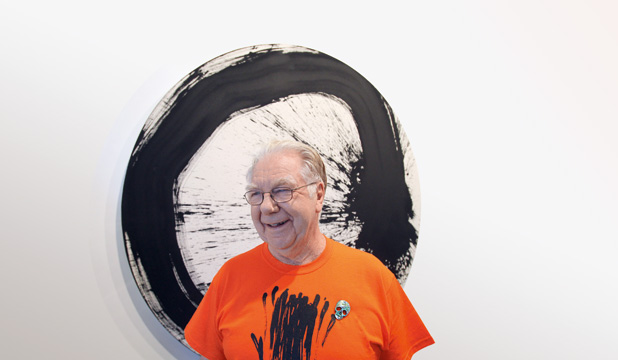
When Max Gimblett was eight he fell in love with America.
With Japan a growing Pacific threat during WWII, American troops moved into Auckland and Wellington in 1942. They also moved into Gimblett’s backyard. “My father bought a second-hand caravan and put it on the back lawn and we had six or seven American soldiers and sailors stay every weekend. I fell in love with them. They became my big brothers,” he says.
From that moment the US would hold a mystical attraction for Gimblett – now one of New Zealand’s most internationally successful artists, home from New York last month, talking to Sunday in between discussing upcoming exhibitions and two teaching stints at Waikato Universityand Auckland’s Elam School of Fine Arts.
He first arrived in New York in 1957, in the era of the civil rights movement and the Beat Generation. “I walked down Broadway. I went into Jack Dempsey’s Restaurant and ordered a steak. I looked up and the heavyweight champ of the world shook my hand. Then I went to a jazz bar and Stan Getz was playing… I was seduced,” he says.
He’s lived there ever since, working from the same 5000-square-foot loft in the Manhattan neighbourhood of the Bowery since 1974. He bought the loft apartment from James Rosenquist, one of the leaders of the pop-art movement. It’s two-thirds studio space and one-third home-cum-library. His wife Barbara Kirshenblatt-Gimblett, who spends time between New York and Warsaw where she is the director of the New Museum of the History of Polish Jews, keeps more than 20,000 books in the loft.
But despite the eternal attraction of the States, Gimblett’s heart remains firmly in New Zealand. “I am very proud to be a New Zealander and I won’t be talked out of it. My ashes are going to be scattered at Bethells. I haven’t lost my New Zealand dialect.”
The loft’s library includes a huge collection of New Zealand cookbooks. And the artist’s birth country has reciprocated the love. He sells well at home and has received the patronage of a number of local galleries. “I believe New Zealand has the highest proportion of art collectors and patrons of any country in the world per head of population,” he says.
“It needs to be acknowledged, how supportive New Zealand has been of my career and me. I have been able to live in New York because of New Zealand.”
Born in 1935, Gimblettwas raised in the Auckland suburb of Grafton. It was an independent childhood in a then rough suburb, with a tough father. He took up boxing at primary school. He would haunt the hallsof the Auckland War Memorial Museum. He battled his father, education and authority.Pushed away from art, he left school before completing fifth form (Year 11) and worked asa textile salesman.
“Creativity is innate,” he says, “but there is the education system to get through.I was closed down from drawing at Grafton primary.” He didn’t draw again until he was 26. When he did start painting again, the clash with authority continued. He lasted just two months at the San Francisco Art Institute. “I was 28 years old and I was unteachable.”
Ad Feedback
New Zealand art curator Hamish Keith visited Gimblett in San Francisco after he had dropped out of art school. “He looked over my shoulder at a pile of my drawings and made some comments. As I bristled he said: ‘You’ve never had a critique have you'”
He found his artistic voice in New York. Mentored by New Zealand filmmaker Len Lye, who lived round the corner in Greenwich Village, Gimblett discovered he had the ambition to be very good at what he did. “He taught me to go for the world stage. He taught me a verbal rap. He taught me to feel very free. He taught me not to be clich